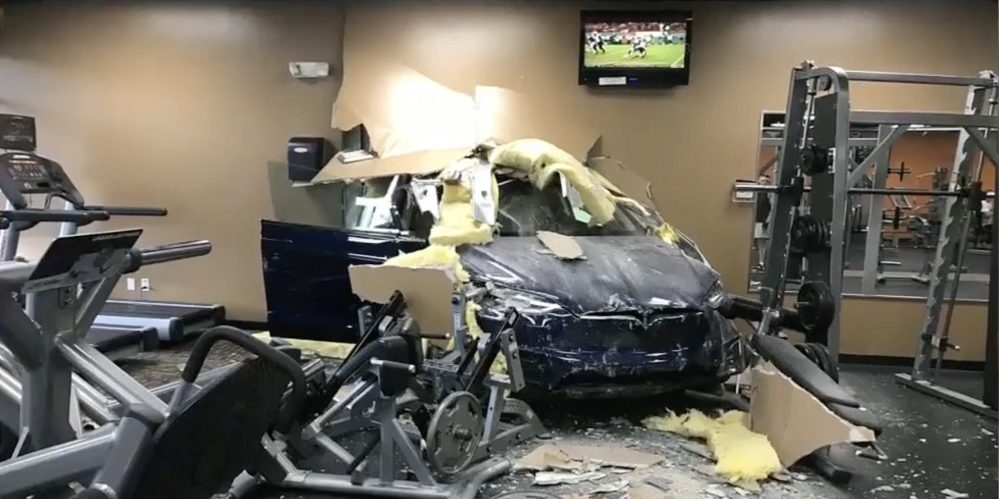Tesla says Autopilot is preventing ~40 crashes per day from wrong pedal errors alone
Tesla claims Autopilot is currently preventing about 40 crashes per day just by correcting drivers pressing the wrong pedal, something that has led Tesla to be accused of sudden acceleration in the past.
Over the years, Tesla vehicles have often been accused of accelerating on their own, resulting in crashes.
These events are called “sudden unintended acceleration,” which can be due to a defect or a driver’s mistake, more often than not from pressing the wrong pedal.
We reported that the National Highway Traffic Safety Administration (NHTSA) said that it is looking into claims that Tesla vehicles have a defect leading to “sudden unintended acceleration” after receiving a petition citing 127 claimed incidents.
As we stated at the time, several claims of sudden unintended acceleration involving Tesla vehicles have been made public over the years. The most publicized one involved a South Korean celebrity claiming his Model X accelerated on its own into his garage.
We have also seen plenty of Tesla vehicles slamming into buildings – most often in a parking situation – like pictured above.
However, in every case, Tesla claimed that the car’s log showed that it was a user mistake due to pedal misapplication, meaning that the driver pressed on the accelerator instead of the brakes.
In one case, Electrek was able to have Tesla’s log verified by a third party, and it supported the automaker’s claims that it showed the driver pressed on the accelerator.
Last year, NHTSA released findings from its investigation and determined that the incidents of sudden acceleration involving Tesla vehicles where drivers said that the vehicles were “accelerating by themselves” were due to user errors.
Following the NHTSA investigation, Tesla issued a statement claiming that there are no defects in its vehicles resulting in unintended acceleration, and that the petition with NHTSA was started by a TSLA short seller.
At the time, Tesla noted that it was using Autopilot to try to prevent those wrong pedal mistakes resulting in accidents:
Unique to Tesla, we also use the Autopilot sensor suite to help distinguish potential pedal misapplications and cut torque to mitigate or prevent accidents when we’re confident the driver’s input was unintentional.
The automaker is using its advanced driver assist (ADAS) technology to try to detect that even though the driver is pressing on the accelerator, they are likely doing it unintentionally and applying the brakes instead.
It is a difficult technology to implement since you generally don’t want to override driver input with ADAS technology.
But Tesla claims to have impressive success with it as Ashok Elluswamy, Tesla’s head of Autopilot software, recently revealing that “Autopilot prevents ~40 crashes per day where human drivers mistakenly press the accelerator at 100% instead of the brakes.”
He even shared an example:
These predictions are already used to prevent a lot of collisions. For e.g., Autopilot prevents ~40 crashes / day where human drivers mistakenly press the accelerator at 100% instead of the brakes. In the video Autopilot automatically brakes, saving this person’s legs (7/12) pic.twitter.com/XtMssPT9cM
— Ashok Elluswamy (@aelluswamy) August 21, 2022
This is a good example of Tesla always getting blamed when there’s an accident where Autopilot is involved, but the automaker doesn’t get credit for all the crashes that it has avoided.
The comment and the example come from a talk that Elluswamy gave for the CVPR 2022 Workshop on Autonomous Driving in June, but it was just released on Youtube last week.
The talk goes into detail about Tesla Autopilot’s use of occupancy networks. It’s certainly more of an inside baseball talk, but it can be interesting to some:
[embedded content]
Subscribe to Electrek on YouTube for exclusive videos and subscribe to the podcast.

Tesla claims Autopilot is currently preventing about 40 crashes per day just by correcting drivers pressing the wrong pedal, something that has led Tesla to be accused of sudden acceleration in the past.
Over the years, Tesla vehicles have often been accused of accelerating on their own, resulting in crashes.
These events are called “sudden unintended acceleration,” which can be due to a defect or a driver’s mistake, more often than not from pressing the wrong pedal.
We reported that the National Highway Traffic Safety Administration (NHTSA) said that it is looking into claims that Tesla vehicles have a defect leading to “sudden unintended acceleration” after receiving a petition citing 127 claimed incidents.
As we stated at the time, several claims of sudden unintended acceleration involving Tesla vehicles have been made public over the years. The most publicized one involved a South Korean celebrity claiming his Model X accelerated on its own into his garage.
We have also seen plenty of Tesla vehicles slamming into buildings – most often in a parking situation – like pictured above.
However, in every case, Tesla claimed that the car’s log showed that it was a user mistake due to pedal misapplication, meaning that the driver pressed on the accelerator instead of the brakes.
In one case, Electrek was able to have Tesla’s log verified by a third party, and it supported the automaker’s claims that it showed the driver pressed on the accelerator.
Last year, NHTSA released findings from its investigation and determined that the incidents of sudden acceleration involving Tesla vehicles where drivers said that the vehicles were “accelerating by themselves” were due to user errors.
Following the NHTSA investigation, Tesla issued a statement claiming that there are no defects in its vehicles resulting in unintended acceleration, and that the petition with NHTSA was started by a TSLA short seller.
At the time, Tesla noted that it was using Autopilot to try to prevent those wrong pedal mistakes resulting in accidents:
Unique to Tesla, we also use the Autopilot sensor suite to help distinguish potential pedal misapplications and cut torque to mitigate or prevent accidents when we’re confident the driver’s input was unintentional.
The automaker is using its advanced driver assist (ADAS) technology to try to detect that even though the driver is pressing on the accelerator, they are likely doing it unintentionally and applying the brakes instead.
It is a difficult technology to implement since you generally don’t want to override driver input with ADAS technology.
But Tesla claims to have impressive success with it as Ashok Elluswamy, Tesla’s head of Autopilot software, recently revealing that “Autopilot prevents ~40 crashes per day where human drivers mistakenly press the accelerator at 100% instead of the brakes.”
He even shared an example:
This is a good example of Tesla always getting blamed when there’s an accident where Autopilot is involved, but the automaker doesn’t get credit for all the crashes that it has avoided.
The comment and the example come from a talk that Elluswamy gave for the CVPR 2022 Workshop on Autonomous Driving in June, but it was just released on Youtube last week.
The talk goes into detail about Tesla Autopilot’s use of occupancy networks. It’s certainly more of an inside baseball talk, but it can be interesting to some:
Subscribe to Electrek on YouTube for exclusive videos and subscribe to the podcast.

